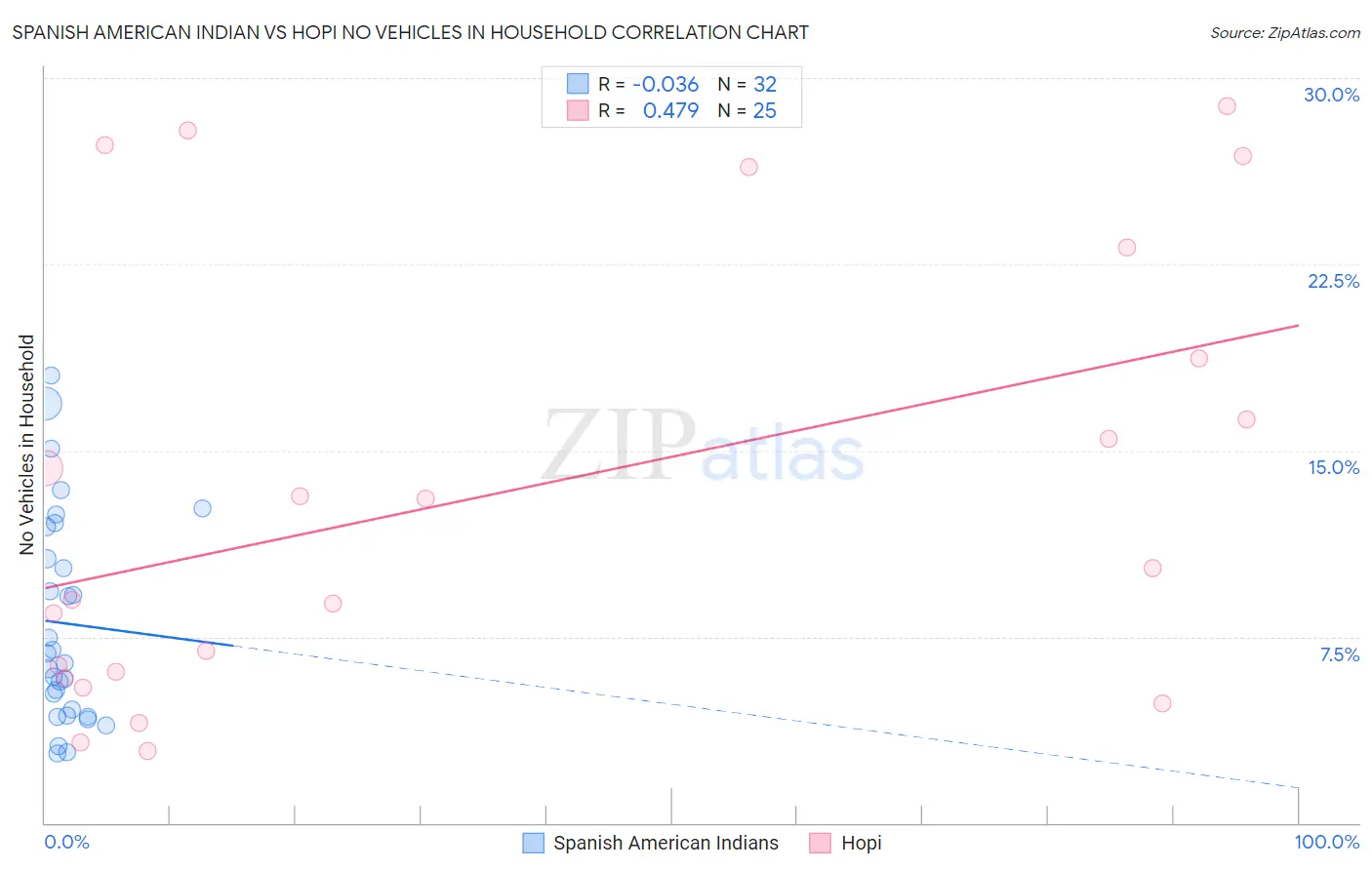Spanish American Indian vs Hopi No Vehicles in Household
COMPARE
Spanish American Indian
Hopi
No Vehicles in Household
No Vehicles in Household Comparison
Spanish American Indians
Hopi
10.1%
NO VEHICLES IN HOUSEHOLD
70.2/ 100
METRIC RATING
158th/ 347
METRIC RANK
13.7%
NO VEHICLES IN HOUSEHOLD
0.0/ 100
METRIC RATING
288th/ 347
METRIC RANK
Spanish American Indian vs Hopi No Vehicles in Household Correlation Chart
The statistical analysis conducted on geographies consisting of 73,126,627 people shows no correlation between the proportion of Spanish American Indians and percentage of households with no vehicle available in the United States with a correlation coefficient (R) of -0.036 and weighted average of 10.1%. Similarly, the statistical analysis conducted on geographies consisting of 74,700,452 people shows a moderate positive correlation between the proportion of Hopi and percentage of households with no vehicle available in the United States with a correlation coefficient (R) of 0.479 and weighted average of 13.7%, a difference of 35.9%.

No Vehicles in Household Correlation Summary
| Measurement | Spanish American Indian | Hopi |
| Minimum | 2.8% | 2.9% |
| Maximum | 18.0% | 28.9% |
| Range | 15.2% | 26.0% |
| Mean | 8.0% | 13.3% |
| Median | 6.6% | 10.2% |
| Interquartile 25% (IQ1) | 4.4% | 5.9% |
| Interquartile 75% (IQ3) | 11.3% | 20.9% |
| Interquartile Range (IQR) | 6.8% | 15.0% |
| Standard Deviation (Sample) | 4.2% | 8.8% |
| Standard Deviation (Population) | 4.1% | 8.6% |
Similar Demographics by No Vehicles in Household
Demographics Similar to Spanish American Indians by No Vehicles in Household
In terms of no vehicles in household, the demographic groups most similar to Spanish American Indians are Australian (10.1%, a difference of 0.060%), Immigrants from Micronesia (10.1%, a difference of 0.11%), Immigrants from Indonesia (10.1%, a difference of 0.15%), Salvadoran (10.1%, a difference of 0.36%), and Sioux (10.1%, a difference of 0.37%).
| Demographics | Rating | Rank | No Vehicles in Household |
| Immigrants | Eastern Africa | 73.8 /100 | #151 | Good 10.0% |
| Immigrants | Congo | 73.0 /100 | #152 | Good 10.1% |
| Tlingit-Haida | 72.5 /100 | #153 | Good 10.1% |
| Sioux | 72.4 /100 | #154 | Good 10.1% |
| Salvadorans | 72.4 /100 | #155 | Good 10.1% |
| Immigrants | Micronesia | 70.9 /100 | #156 | Good 10.1% |
| Australians | 70.6 /100 | #157 | Good 10.1% |
| Spanish American Indians | 70.2 /100 | #158 | Good 10.1% |
| Immigrants | Indonesia | 69.3 /100 | #159 | Good 10.1% |
| Immigrants | Middle Africa | 65.7 /100 | #160 | Good 10.2% |
| New Zealanders | 65.1 /100 | #161 | Good 10.2% |
| Immigrants | Austria | 64.4 /100 | #162 | Good 10.2% |
| Immigrants | Cambodia | 63.7 /100 | #163 | Good 10.2% |
| South Africans | 61.1 /100 | #164 | Good 10.2% |
| Comanche | 60.8 /100 | #165 | Good 10.2% |
Demographics Similar to Hopi by No Vehicles in Household
In terms of no vehicles in household, the demographic groups most similar to Hopi are Immigrants from Ireland (13.7%, a difference of 0.13%), Colville (13.7%, a difference of 0.35%), Immigrants from Australia (13.8%, a difference of 0.66%), Immigrants from Eastern Europe (13.6%, a difference of 1.0%), and Immigrants from Malaysia (13.6%, a difference of 1.1%).
| Demographics | Rating | Rank | No Vehicles in Household |
| Central American Indians | 0.0 /100 | #281 | Tragic 13.3% |
| Immigrants | Eastern Asia | 0.0 /100 | #282 | Tragic 13.5% |
| Immigrants | Kazakhstan | 0.0 /100 | #283 | Tragic 13.6% |
| Immigrants | Malaysia | 0.0 /100 | #284 | Tragic 13.6% |
| Immigrants | Eastern Europe | 0.0 /100 | #285 | Tragic 13.6% |
| Colville | 0.0 /100 | #286 | Tragic 13.7% |
| Immigrants | Ireland | 0.0 /100 | #287 | Tragic 13.7% |
| Hopi | 0.0 /100 | #288 | Tragic 13.7% |
| Immigrants | Australia | 0.0 /100 | #289 | Tragic 13.8% |
| Indians (Asian) | 0.0 /100 | #290 | Tragic 14.1% |
| Okinawans | 0.0 /100 | #291 | Tragic 14.1% |
| Pima | 0.0 /100 | #292 | Tragic 14.1% |
| Immigrants | Jamaica | 0.0 /100 | #293 | Tragic 14.2% |
| Belizeans | 0.0 /100 | #294 | Tragic 14.3% |
| Paraguayans | 0.0 /100 | #295 | Tragic 14.4% |